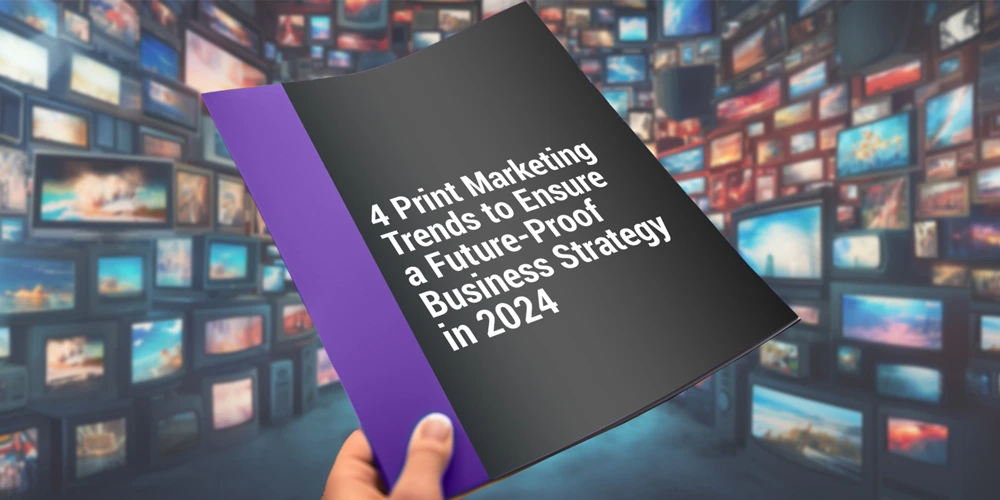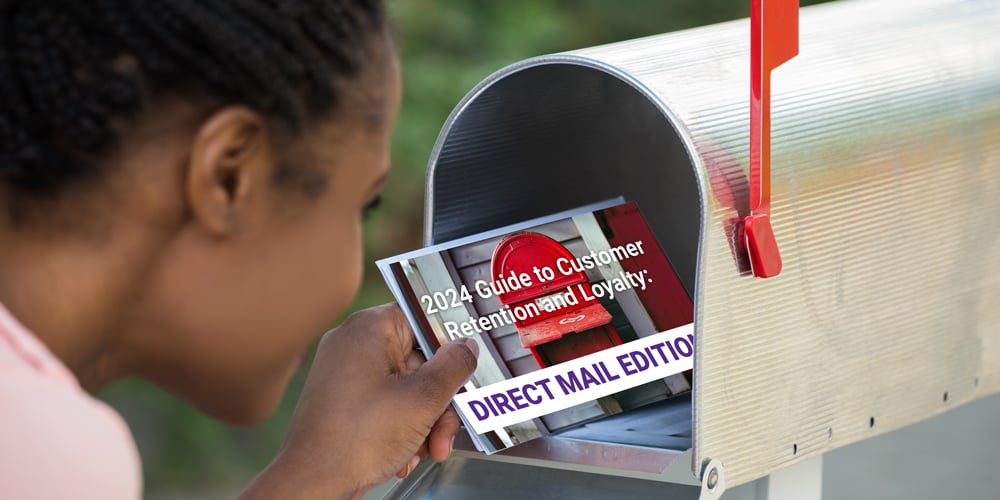Print Marketing: 4 Trends Shaping Business Strategies in 2024

Looking for print marketing trends for 2025? Read the 2025 edition of this article here.
New tech and must-follow trends emerged overnight in 2023. From the rise of AI to the dramatic makeover at Twitter X to the unraveling of Threads after its 15 minutes of fame, marketing strategy pivots became the norm.
Growing concerns over data privacy added more complications to the mix, with 86% of businesses reporting that privacy changes impacted their 2023 marketing strategy.
The digital disruptions of 2023 have prioritized flexibility as a key ingredient for future marketing strategies—they have also positioned print as one of the strongest and safest marketing bets in 2024.
Keep reading to learn how your business can leverage these print marketing trends to boost performance, ROI, and overall marketing effectiveness in 2024 and beyond.
- Prints Solutions That Solved Email Marketing Challenges
- Frequent Marketing Strategy Pivots Relied on Modern Print Management Solutions
- Personalized Print Marketing Outperformed Digital Automation
- Increased Focus on Multi-Channel Marketing Brand Consistency
Print Solutions That Solved Email Marketing Challenges
The pandemic created a major shift toward virtual business operations and online shopping, leading to a 70% increase in email volume between 2020 to 2022. This influx, however, coincided with a 10% decrease in click-through rates in 2023.
Further, Apple’s Mail Privacy Protection (MPP) added a new layer of complexity to email marketing by disrupting the measurement of open rates. Since MPP preloads email content on Apple devices, it prevents tracking pixels from collecting open rate data. Consequently, open rate data was hidden for more than 40% of emails in 2023, making it extremely difficult for marketers to optimize and report on email campaigns.
To work around the challenges of inbox inundation and masked open rates, savvy marketers supplemented email campaigns with print. Why print?
- Print has a 9% response rate compared to digital channels, which average around 1%.
- Direct mail campaigns have open rates as high as 90%, and tracking response rates is easy.
Here are two common ways to leverage print to boost response rates and report on campaign performance:
- After deploying an email campaign, filter the distribution list by recipients who did not open the email. Next, send a direct mail piece that includes a unique QR code or URL that is specific to the print component of the campaign.
- Sending a direct mail piece before an email campaign works just as well. In fact, businesses that sent a follow-up email one week after sending a direct mail piece boosted response rates by 63%.
Frequent Marketing Strategy Pivots Relied on Modern Print Management Solutions
To thrive in 2024, businesses need to prepare for the challenge of change; but how are marketing teams supposed to keep up with the frequent strategy pivots?
The answer: a print marketing portal.
A print marketing portal centralizes all your print materials and branded assets in an easy-to-use online hub. The centralized nature of a marketing portal allows 24/7 access for employees, sales reps, partners, affiliates, and even customers to order the up-to-date print marketing materials they need right when they need them.
Should a change in pricing, consumer behavior, regulations, or trends occur, a marketing portal with 24/7 access makes it easy to update print marketing collateral as quickly as a new file is uploaded.
Struggling with outdated marketing materials after printing in bulk?
A print marketing portals eliminates the need for printing in bulk, making it extremely easy to update print marketing assets in real-time and without the waste (or expense) of throwing away 100,000 outdated brochures.
Marketing portals use a just-in-time printing model, which means that small batches of print marketing materials (such as brochures, flyers, or product catalogs) are pre-printed, stored in a secure warehouse, and ready for shipment as soon as orders come in through the portal.
This allows for real-time changes to print marketing assets, ensures print collateral is always up-to-date, and makes it fast and easy to update print materials.
Personalized Print Marketing Outperformed Digital Automation
Personalized marketing has been a top trend for years, and for good reason. Nearly 90% of businesses saw higher conversion rates with personalized marketing.
While personalized digital marketing has its merits, creating a sense of authenticity and personal connection is difficult to achieve on a computer or phone. Further, people are aware of the fact that email personalization tokens and chatbot interactions are automated, lacking a true reflection of a business’s personal attention to their individual needs.
The growing skepticism over online privacy and data collection methods further undermines digital personalization techniques, raising more concerns than conversions.
Print marketing, on the other hand, has an intrinsic trustworthiness that resonates with audiences who are untrusting of and overwhelmed by digital ads. Fun fact: print is the most trusted marketing channel among 82% of consumers.
And when the inherent trustworthiness of print is paired with personalization, the results are extraordinary.
If your business hasn’t implemented personalization strategies yet, now is the time to get started (and it's easier than you might think).
Modern digital printing technology, known as variable data printing, is a form of digital printing that allows for names, text, images, and more to change from one printed piece to the next in a single print run.
Since variable data printing technology uses data from a CRM, database, or external file to personalize each printed piece, there’s no need to design 100,000 different files for 100,000 unique prints. Instead, a single design template is used, and the variable data is automatically inserted into each piece.
Nearly any element of a printed piece can be personalized with variable data printing, including:
- Names and company names.
- Colors and images.
- QR codes or URLs.
- Contact information for different locations or sales reps.
- Special offers and promotions based on purchase history or location.
Increased Focus on Multi-Channel Brand Consistency
Clear and consistent branding is essential for any business, especially when it comes to integrated marketing campaigns that combine print and digital.
For instance, when a QR code is added to print materials, displays, or signage, the digital experience that unfolds needs to reflect the same branding, messaging, and visual elements as the print piece.
As businesses increasingly integrate print and digital media, understanding the technical aspects of designing for print and digital channels has become essential.
It’s important to note that artwork for print campaigns and digital channels should not be used interchangeably. For instance, a website graphic is not formatted for either large-format printing, such as a window display, or small-format printing, such as postcards or business cards. The reason is that digital graphics and print use different color profiles.
Designs created for digital channels typically use RGB color profiles that look best on computer screens or mobile phones, whereas print artwork requires CMYK color profiles.
If you're struggling with achieving consistent colors across print and digital channels, you may want to consider partnering with premedia experts who can ensure every design and brand color is translated perfectly across print and digital channels.
Fortify Your Print Marketing Strategy with Artisan Colour
For more than 27 years, Artisan Colour has set the standard for high-quality digital printing.
Since our beginning in 1998 as one of the nation’s top print and catalog production partners for brands such as Amazon, Neiman Marcus, and Patagonia, Artisan Colour has continuously invested in innovative solutions and expanded our service offerings to meet the demands of modern business.
Today, we offer an extensive suite of services, including:
- Small-Format Printing: Marketing collateral, catalogs, custom packaging, and Interactive Paper.
- Large-Format Printing: Business signage, wall and window graphics, indoor and outdoor banners, trade shows and events, retail displays, and wall wraps.
- Direct Mail: SOC 2-compliant direct mail campaigns and personalized direct mail.
- Marketing Fulfillment: Warehousing, storage, inventory management, kitting, assembly, order processing, and shipping.
- Premedia: Image editing, prepress, color management, proofing, and calibrated product photography.
- Digital Marketing: Website design, content marketing, SEO, social media, multi-channel integrations, and Hubspot ecosystem management.
While our suite of services has expanded over the years, our commitment to quality, precision, and craftsmanship remains unchanged.
Contact our team of artisans today to learn more about what Artisan Colour can do for your organization.







